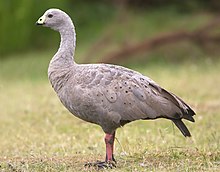Lake Newland Conservation Park
| Lake Newland Conservation Park South Australia | |
|---|---|
| Nearest town or city | Elliston |
| Coordinates | 33°24′18″S 134°51′16″E / 33.40500°S 134.85444°E[1] |
| Established | 1 August 1991[2] |
| Area | 88.8 km2 (34.3 sq mi)[3] |
| Managing authorities | Department for Environment and Water |
| Website | Lake Newland Conservation Park |
| See also | Protected areas of South Australia |
Lake Newland Conservation Park is a
History and description
The conservation park is located within the gazetted localities (from south to north) of Elliston,
Land within the conservation park has a relatively recent geological history, with Holocene sand dunes creating a barrier between the Southern Ocean and a depression in the Bridgewater Formation of Pleistocene limestone that is common throughout the western Eyre Peninsula.[6]
The
Lake Newland was named by Edward John Eyre for his friend and travelling companion Richard Francis Newland, during his Eyre's 1839 expeditions to the west.[4][8]
The conservation park was proclaimed in 1991 (named after the lake[4]), with some additional land being added in 1996.[6]
It is classified as an
Vegetation
The conservation park contains mobile sand dunes and sub-coastal wetlands. The vegetation includes areas of previously cleared land with patches of regenerating
Other designations

The full extent of the conservation park is overlapped by an Important Bird Area (IBA) known as the Lake Newland Important Bird Area. The IBA which is a non-statutory arrangement has been identified by BirdLife International because it regularly supports over 1% of the world population of Cape Barren geese, as dry-season visitors from their offshore island breeding grounds, and significant numbers of fairy terns and hooded plovers.[9] Slender-billed thornbills also occur in the park.[6]
In Aboriginal mythology
Lake Newland is steeped in
References
- ^ a b c "Terrestrial Protected Areas of South Australia (refer 'DETAIL' tab )". CAPAD 2016. Australian Government, Department of the Environment (DoE). 2016. Retrieved 21 February 2018.
- ^ Rann, M.D. (1 August 1991). "NATIONAL PARKS AND WILDLIFE ACT 1972 SECTIONS 30 AND 43: CONSTITUTION OF, AND MINING IN, CONSERVATION PARK" (PDF). The South Australian Government Gazette. Government of South Australia. p. 490. Retrieved 2 July 2019.
- ^ "Protected Areas Information System - reserve list (as of 25 November 2014)" (PDF). Department of Environment Water and Natural Resources. Retrieved 8 January 2015.
- ^ a b c "Search result for "Lake Newland Conservation Park" (Record no. SA0038338) with the following layers selected - "Suburbs and Localities" and " Place names (gazetteer)"". Property Location Browser. Government of South Australia. Archived from the original on 12 October 2016. Retrieved 16 November 2016.
- ^ a b c Hamilton, Jodie (7 October 2020). "Seven Sisters stars creation story reconnecting people to their country after clifftop massacre taboo lifted". ABC News. Australian Broadcasting Corporation. Retrieved 11 November 2020.
- ^ a b c d e Durant, M.D. (2009). Lake Newland Conservation Park: Opportunities for Implementation of the WildEyre Conservation Action Plan (PDF). Report to the WildEyre project group. Greening Australia SA.
- ^ Jonscher, Samantha (14 October 2018). "Waterloo Bay monument to historic massacre allows community to reflect on reconciliation since opening". ABC News. Australian Broadcasting Corporation. Retrieved 12 November 2020.
- ^ "Journal of Expeditions in Central and Southern Australia". The South Australian. Vol. IX, no. 708. South Australia. 24 February 1846. p. 3. Retrieved 15 November 2016 – via National Library of Australia.
- ^ "IBA: Lake Newland". Birdata. Birds Australia. Archived from the original on 6 July 2011. Retrieved 29 July 2011.

